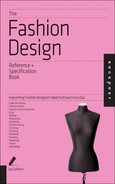
Job:02-30034 Title:RP-Fashion Design Ref and Spec Book
#175 Dtp:225 Page:210
210-223_30034.indd 210 3/5/13 6:38 PM
210 THE FASHION DESIGN REFERENCE + SPECIFICATION BOOK
(Text)
Chapter 21: Shows
The show business side of fashion is a combination of wedding ceremony and
rock concert. As theatrical and as fun as this might sound, putting together a
full-scale runway show is about impeccable organization and precise follow-
through. The culmination of all available research and support systems should
be a spectacle that is executed professionally and worth remembering.
COMPONENTS
Intent
What goes into the structure of a show will hinge on who is in the audience. Fashion shows
are not one-size- ts-all events. The consumer most often wants to be entertained and swept
away into the designer’s fantasy. The general press is there to get something newsworthy, a
great photograph, or a celebrity sighting. The fashion press and the buyers represent speci c
publications or retailers and their customer base. They are looking to see how these clothes
will t into their plans for the upcoming season.
Flow
The event must be set up so that everything ows through it by design, including when guests
will be given access and be able to interact. The designer should be conscious of removing
obstacles and distractions as well as modulating the pace and direction of the experience.
Each step of the event should build upon the last, so that the sequence provides pay offs
throughout. Balancing the distribution of these rewards with the right amount of downtime will
keep the audience engaged and interested.
Illusion Making
Misdirection and sleight of hand are instrumental in helping an audience suspend disbelief
and enjoy the experience of illusion making. Light, sound, and visual distractions will build a
sensory environment that focuses the minds of the audience, who should pay no attention
to the designer behind the curtain—until its time to take a bow. A good fashion show is the
result of much practice and the mastery of technical details.
Photograph by Peter Kramer/Getty Images for IMG.
21
Job:02-30034 Title:RP-Fashion Design Ref and Spec Book
#175 Dtp:225 Page:210
210-223_30034.indd 210 3/5/13 6:37 PM

Job:02-30034 Title:RP-Fashion Design Ref and Spec Book
#175 Dtp:225 Page:211
Book
e:210
210-223_30034.indd 211 3/5/13 6:38 PM
211
(Text)
s
l
Preparing for Mercedes-Benz Fashion Week, Fall 2007, New York
Photograph by Peter Kramer/Getty Images for IMG.
21
Job:02-30034 Title:RP-Fashion Design Ref and Spec Book
#175 Dtp:225 Page:211
Book
e:210
210-223_30034.indd 211 3/5/13 6:37 PM

Job:02-30034 Title:RP-Fashion Design Ref and Spec Book
#175 Dtp:225 Page:212
210-223_30034.indd 212 3/5/13 6:38 PM
212 THE FASHION DESIGN REFERENCE + SPECIFICATION BOOK
(Text)
In
A
th
ty
tio
ity
an
w
ey
du
th
C
Li
th
m
Pl
ba
of
Vogue editor Anna Wintour with designer Karl Lagerfeld before the presentation of
Lagerfeld’s Spring/Summer 2009 Collection, Paris Fashion Week
Photograph by Scott Wintrow/Getty Images.
Photograph by Eric Ryan/Getty Images.
21
Job:02-30034 Title:RP-Fashion Design Ref and Spec Book
#175 Dtp:225 Page:212
210-223_30034.indd 212 3/5/13 6:37 PM

Job:02-30034 Title:RP-Fashion Design Ref and Spec Book
#175 Dtp:225 Page:213
Book
e:212
210-223_30034.indd 213 3/5/13 6:38 PM
Shows 213
(Text)
Installations
A popular alternative to fashion shows are exhibits and installations, which might incorporate
the actual garments in traditional displays or take shape as digital or video art. To curate this
type of presentation, the designer walks a ne line between art and advertising. Collabora-
tions with dedicated artists and lmmakers provide checks and balances to ensure the viabil-
ity and integrity of the project. Fashion patrons with a penchant for the arts can intellectualize
and appreciate a designer’s work in an environment rich with the cultural trappings of the art
world. Of course, sometimes such installations will appear in less rari ed contexts, with an
eye to a pop-cultural sensibility. Although live models may not be a component of these pro-
ductions, the need for spectacle remains part of the equation. Designers must consider how
these presentations will be preserved, repeated, reinterpreted, or repurposed.
CHECKLISTS
Like any event the designer undertakes, from product launches to television appearances,
the fashion show requires extensive and detailed planning. Live events are also about crowd
management, for when dealing with people in numbers the variables increase exponentially.
Planning for every contingency requires designers to create, manage, and complete three
basic checklists: preshow preparation, showtime, and postshow wrap-up. The items on each
of these lists will vary, depending on the scope.
Target’s model-less fashion show on a video screen in
Grand Central Terminal, 2007
Photograph by Scott Wintrow/Getty Images.
Photograph by Eric Ryan/Getty Images.
21
Job:02-30034 Title:RP-Fashion Design Ref and Spec Book
#175 Dtp:225 Page:213
Book
e:212
210-223_30034.indd 213 3/5/13 6:37 PM

Job:02-30034 Title:RP-Fashion Design Ref and Spec Book
#175 Dtp:225 Page:214
210-223_30034.indd 214 3/5/13 6:38 PM
214 THE FASHION DESIGN REFERENCE + SPECIFICATION BOOK
(Text)
Photograph by Pierre Verdy/AFP/Getty Images.
Polaroid wall backstage at Anna Sui, Spring/Summer 2006
Ready-to-Wear, Olympus Fashion Week, New York
Hair prep backstage at Givenchy, Spring/Summer 2009
Ready-to-Wear, Paris Fashion Week
Photograph by Bryan Bedder/Getty Images.
21
Job:02-30034 Title:RP-Fashion Design Ref and Spec Book
#175 Dtp:225 Page:214
210-223_30034.indd 214 3/5/13 6:37 PM
..................Content has been hidden....................
You can't read the all page of ebook, please click here login for view all page.
